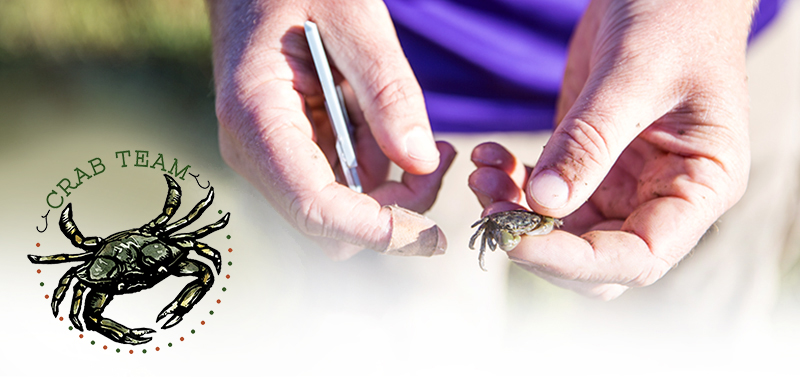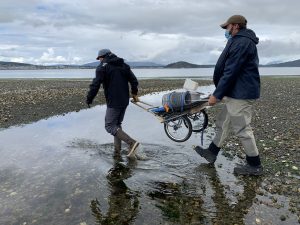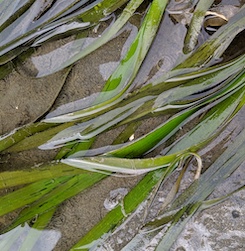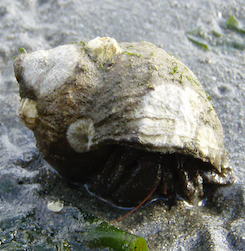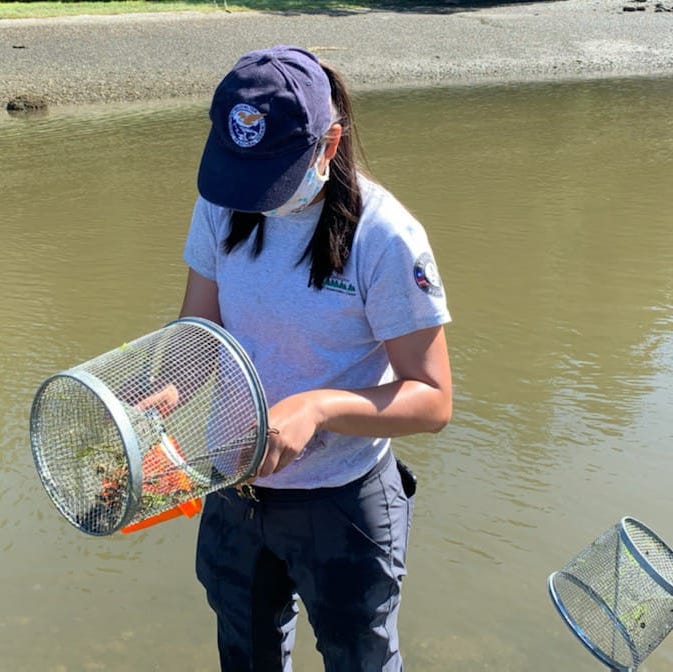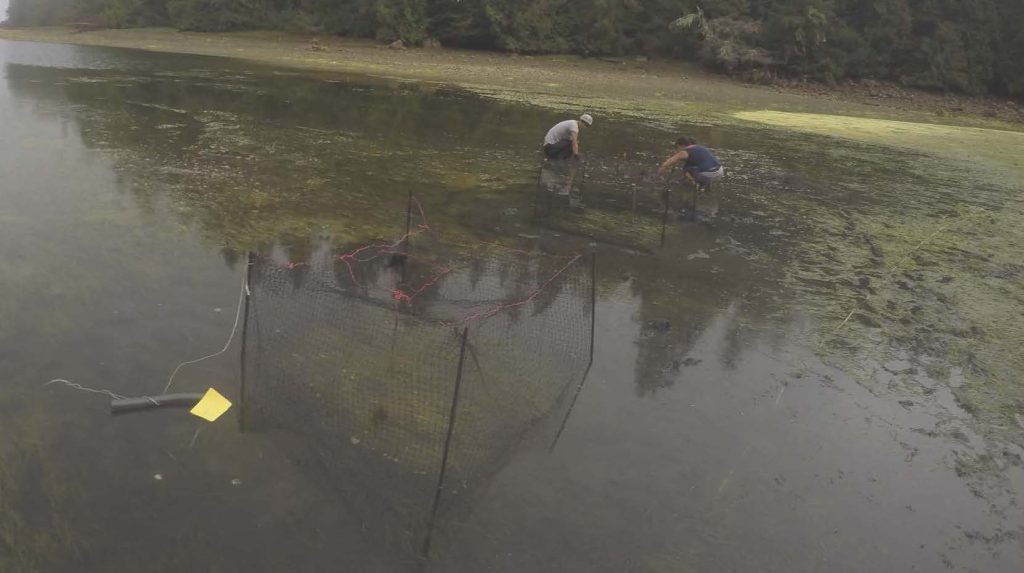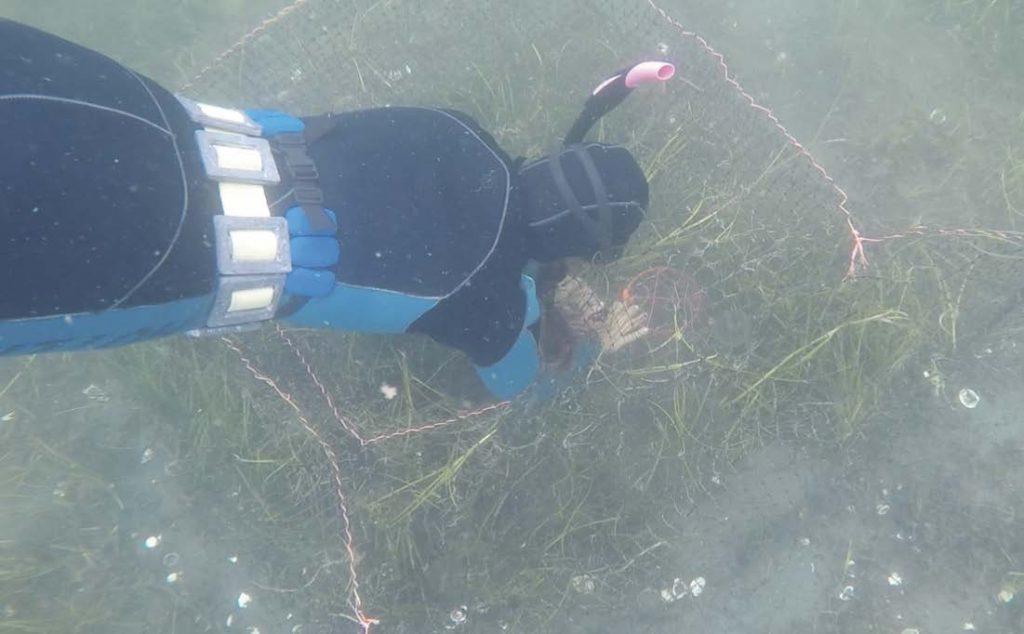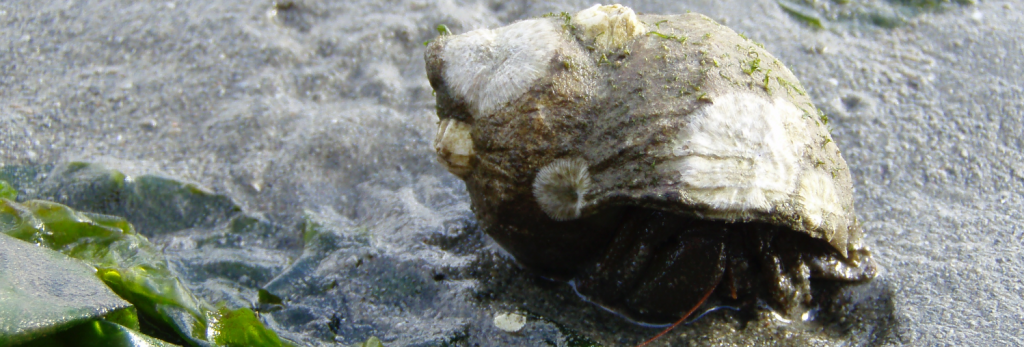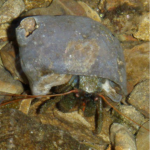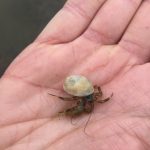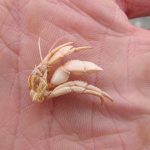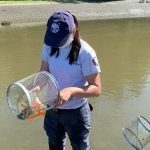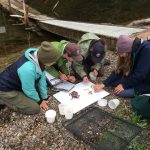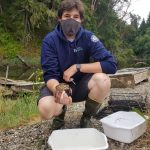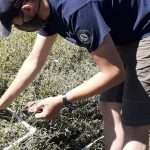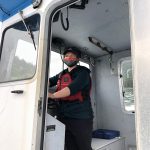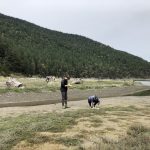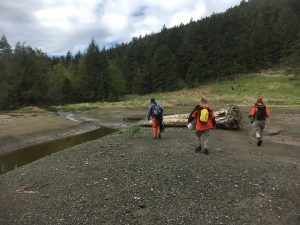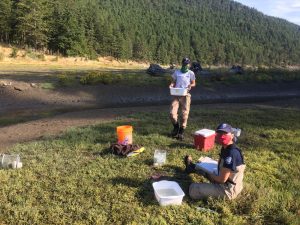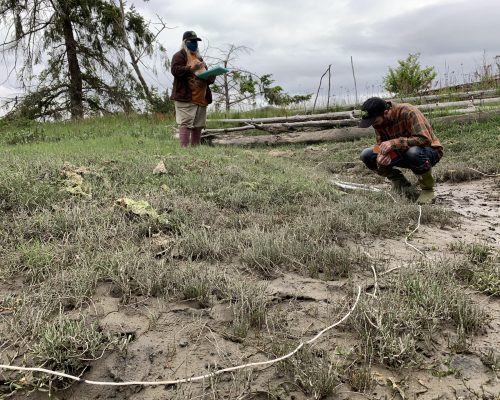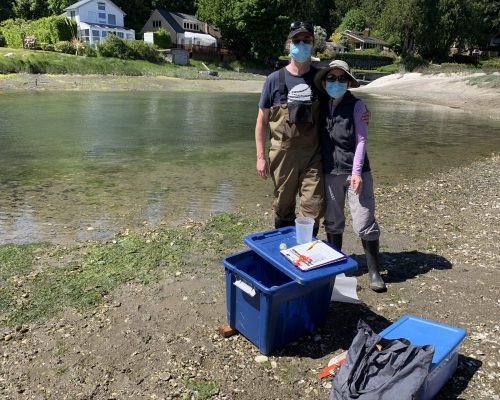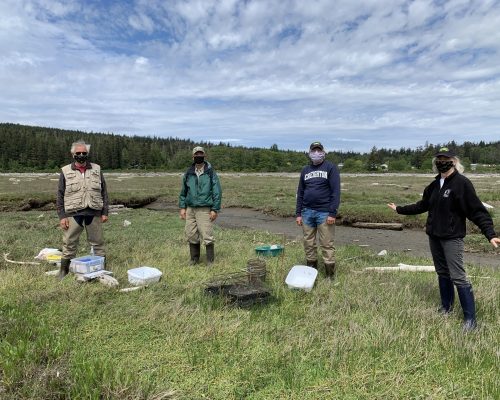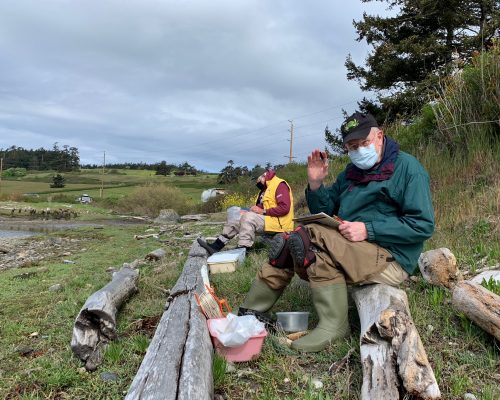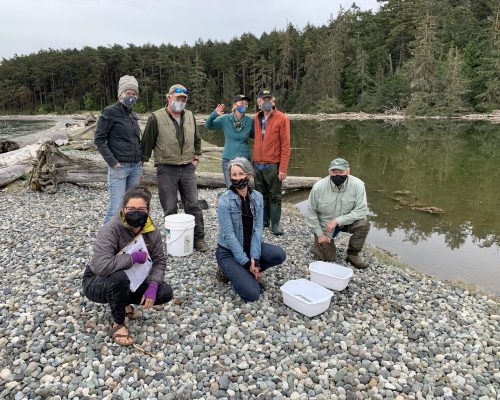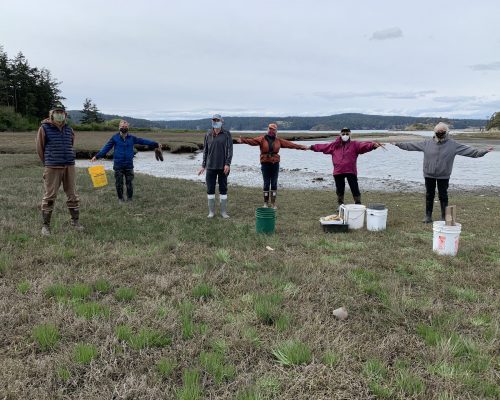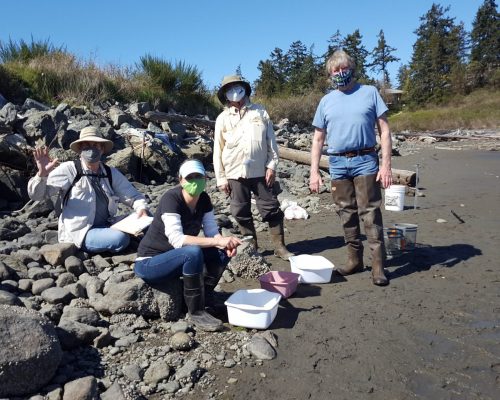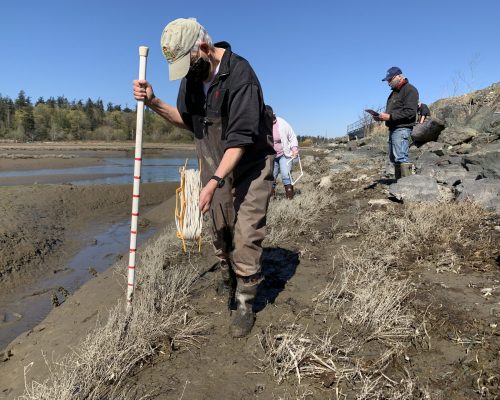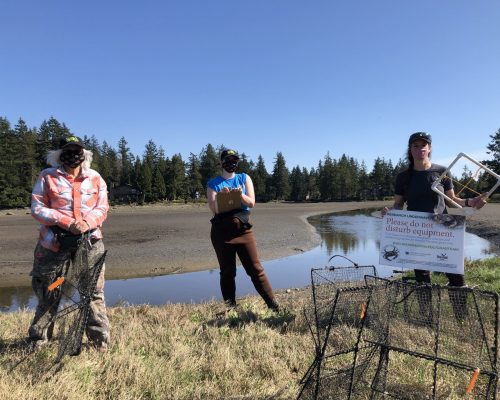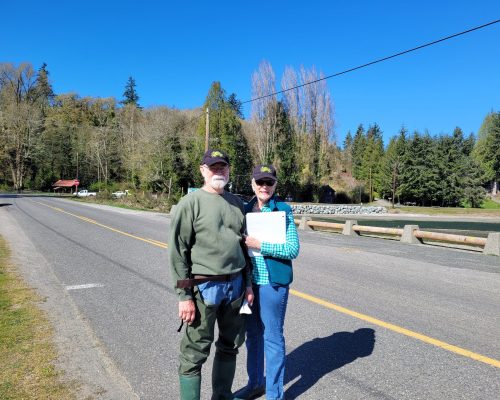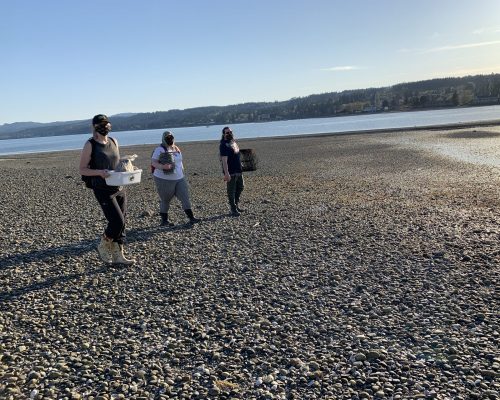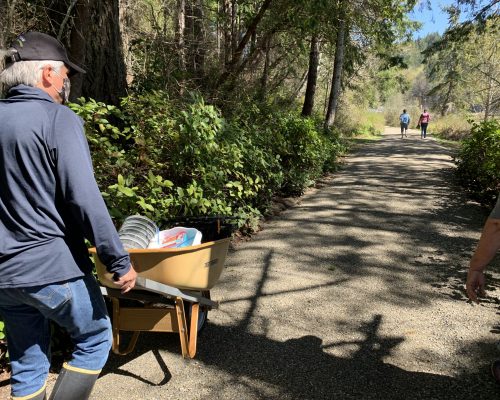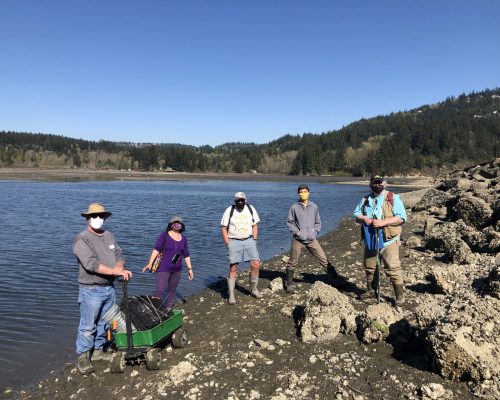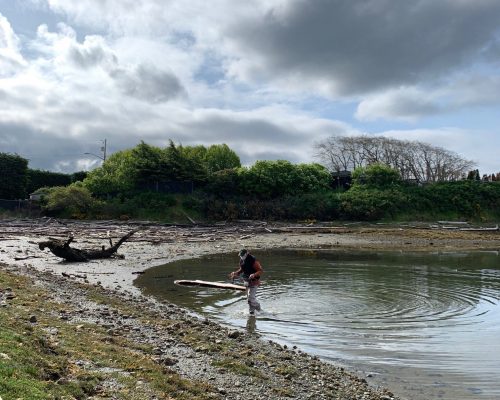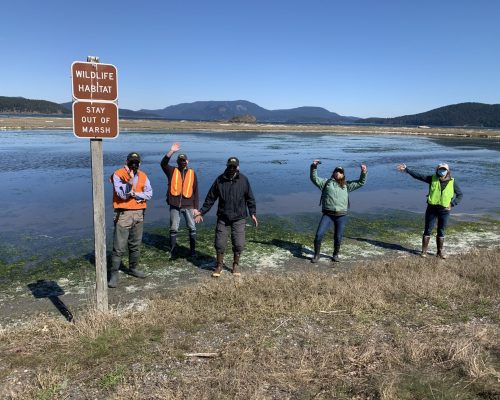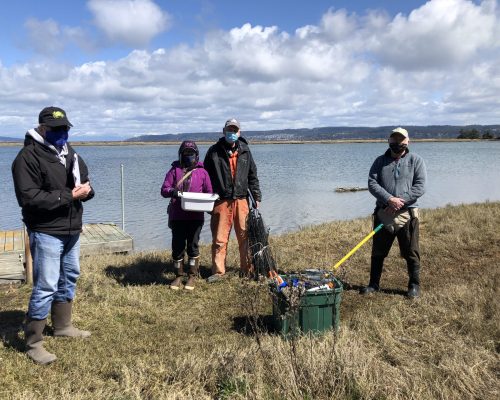Let the trapping begin!
June, 2021
This spring had a lot of us reflecting on what our lives were like a year ago. In June 2020, crabbers were in the mud, just as they are now, but how they got there in 2021 looked a lot different. While green crab efforts in 2020 managed to outpace all previous years, doing so required a lot of flexibility on the part of Crab Team monitors, and the growing list of partners expanding capacity to manage green crab in Washington. Let’s just say there were some bumps in the road, and it is much to the credit of the people involved that everything was so successful. This year, we had a better idea of what was coming and how to plan for it. For instance, while Crab Team had to cancel all of our training workshops in 2020, this past winter gave us time to prepare virtual trainings and now we are excited to introduce a new cohort of trained volunteers and partner staff to the monitoring corps this year.
Like many of you, we have expanded what was possible using virtual platforms over the past year, from hosting educational workshops for WSG Crab Team monitors this winter to conducting our entire training series online. As a program, we haven’t been able to see many Crab Teamers in person for quite some time, but we are grateful for these alternative avenues to stay connected over the past year. As we reflect on the changes we’ve made in response to the pandemic, we plan to keep some of the things we’ve learned along the way and incorporate more virtual learning opportunities into our programming into the future.
Some aspects of life-in-person are irreplaceable through virtual media, however, and no amount of Zoom will lure the crabs out of the mud and into our work-from-home spaces, so we are relieved to be back in the field. Statewide, there have never been more traps in the water, or more groups conducting trapping for green crabs, than there are this spring. The increasing urgency of the threat from green crabs means we have to build our response capacity even faster, and this was a theme of a Washington State European green crab update meeting hosted by WDFW last winter (the recording is available). From early detection, monitoring, assessment, removal, the range of efforts might look slightly different, and engage different groups, but collectively, we are all working toward one goal: protecting shorelines.
All our pinchy best,
Crab Team HQ
Green Crab: Elephants in the Eelgrass
Guest contributor Brett Howard completed her Ph.D. research at Simon Fraser University focused on the impacts of European green crab on ecosystems in British Columbia. She currently works for Fisheries and Oceans Canada, the federal governmental department that manages fisheries.
Some species can change landscapes so substantially that they become symbols for ecosystem health and conservation. The classic example is the beaver, a species that can create diverse wetlands by the simple act of industrious dam construction. Destruction and disturbance are often equally effective forms of landscape transformation. Large herbivores may break, tear, or stomp over vegetation, dig massive pits in search of water, and leave behind concentrated deposits of nutrients in their dung. A herd of elephants is not subtle. Whether constructive or destructive, these species are considered allogenic ecosystem engineers, meaning the origin of change is a consequence of an animal’s behavior. This is in contrast to autogenic ecosystem engineers, where the species themselves are the habitat. Many plants, algae, and sessile invertebrate species, like oysters, fall into this category. For example, the iconic large brown seaweeds of kelp forests are the foundation for an ecosystem that supports everything from the smallest invertebrates to sea otters.
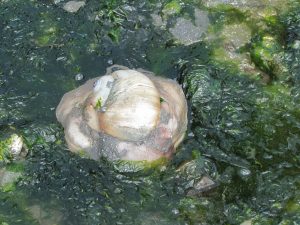
Lewis’ moon snail (Neverita lewisii) making headway in the intertidal zone. Photo courtesy of Jeff Adams
Oysters and kelps are not the only autogenic ecosystem engineers along the West Coast. The native eelgrass Zostera marina is a critical nearshore habitat that turns structureless mudflats into three-dimensional habitat. Anyone who has kayaked over an eelgrass bed at high tide has likely seen the comings and goings of a diverse range of species, like the giant, white Lewis’ moon snail (Neverita lewisii) or the bright green bay pipefish (Syngnathus leptorhynchus). There are numerous transient species that move into eelgrass beds to forage or to evade predators. Juvenile rockfish (Sebastes spp.) and Dungeness crab (Cancer (Metacarcinus) magister) are common in eelgrass beds as well as out-migrating juvenile salmon.
The ecological importance of eelgrass has incentivized federal, state, and provincial governments in both the USA and Canada to put regulations in place to protect these habitats. This protection is necessary, as eelgrass beds have been declining globally due to environmental stressors like rising water temperatures, excess nutrients, and alteration and construction along shorelines (e.g., armoring, docks, boardwalks, marinas, etc.).
In the early 2000s a new threat to eelgrass was identified on the east coast of North America where researchers took notice of massive, sudden declines in eelgrass beds that coincided with large populations of invasive European green crab. After 75 percent of the plants in Benoit Cove, Nova Scotia were lost over a single summer, researchers tested the hypothesis that green crabs were allogenic ecosystem engineers in this system by studying the effects of green crabs caged in an eelgrass bed (Garbary et al. 2014).The use of cages in field studies is meant to keep one aspect of the environment constant (in this case the presence or absence of green crabs) while allowing all other experimental conditions to be dictated by real-world conditions. These types of experiments may use enclosures, where the cages keep crabs in, so there is a “known density,” or exclosures, where the cages keep crabs out. The enclosure experiment in Nova Scotia showed that plants inside the cages were shredded or uprooted by green crabs while they foraged in the soft sediment. The negative correlation between green crab presence and eelgrass (i.e. the more green crab, the less eelgrass), especially at high crab densities, was further supported by similar studies in Newfoundland, Prince Edward Island, Canada and Maine, USA (Malyshev & Quijón 2011; Neckles 2015; Matheson et al. 2016). It seemed that in large numbers, green crabs could have profound impacts on this critical habitat. The change in habitat from eelgrass bed to mudflat by green crabs exemplifies allogenic ecosystem engineering.
When considering the issue of invasive green crabs on Vancouver Island, BC these studies caught my attention. After all, the species of eelgrass affected on the east coast was the same as that found on the west coast, Z. marina. Would green crabs have the same impact on our eelgrass beds?
My colleagues, Drs. Fiona Francis, Isabelle Côté, and Thomas Therriault, and I tested the interaction between green crabs and eelgrass on the West Coast by placing green crabs in enclosures at high and low densities (5.6 and 1.4 crabs per square meter, respectively) in an eelgrass bed on the southwest side of Vancouver Island.
From surveys done by the Department of Fisheries and Oceans Canada, we know this range approximates the densities of green crabs at moderate and very high-density sites elsewhere in the region. Over the course of one month, we measured the change in both eelgrass blades (leaves of the plant) and rhizomes (similar to roots) inside and outside the enclosures. How green crabs impact these two parts of the plant affects plant regeneration and overall bed persistence. If green crabs were just removing the blades, like a lawnmower or a grazing herbivore in a grassland, the root structure of the grass would remain intact, likely allowing the plant to regrow quickly. By comparison, if green crabs are more like elephants, pulling out plants, roots and all, it could mean a larger or more permanent impact to eelgrass beds. All this talk of herbivory might suggest that green crabs are eating eelgrass. To determine if there was herbivory going on, or if the damage to the eelgrass was simply incidental, we dissected the stomachs of enclosed crabs and had the contents analyzed for eelgrass DNA.
As with the experiments on the East Coast, we observed a significant decline in eelgrass blades in our highest density crab treatment. These enclosures lost 73 – 81 percent more blades than the low-density ones. On average, the number of blades in the high-density enclosures decreased by almost 2 percent every day, due to green crab activities.
This is an extraordinary rate of loss, up to three times faster than the natural loss of blades over the same time during this experiment. Yet, is also important to keep in mind that these numbers reflect the effect of green crabs in an unnatural setting: an enclosure. In nature, green crabs will move around a bed and with the tide, so their effect is unlikely to be as concentrated as it was in our experiment. Regardless of the specific numbers, what this experiment reveals is that green crabs will damage eelgrass plants as a consequence of their behaviors, and this damage scales with crab density. This raises concerns about the long-term stability of eelgrass beds on the West Coast with high densities of green crabs (i.e., greater than ~5 crabs per square meter). When we looked at the high-density enclosures in closer detail, we found the rhizomes did largely remain intact under the sediment, suggesting the eelgrass might be able to regrow quickly in the absence of green crabs. Our experiment ended before we could track this, however, so future study would be needed to confirm that recovery does take place.
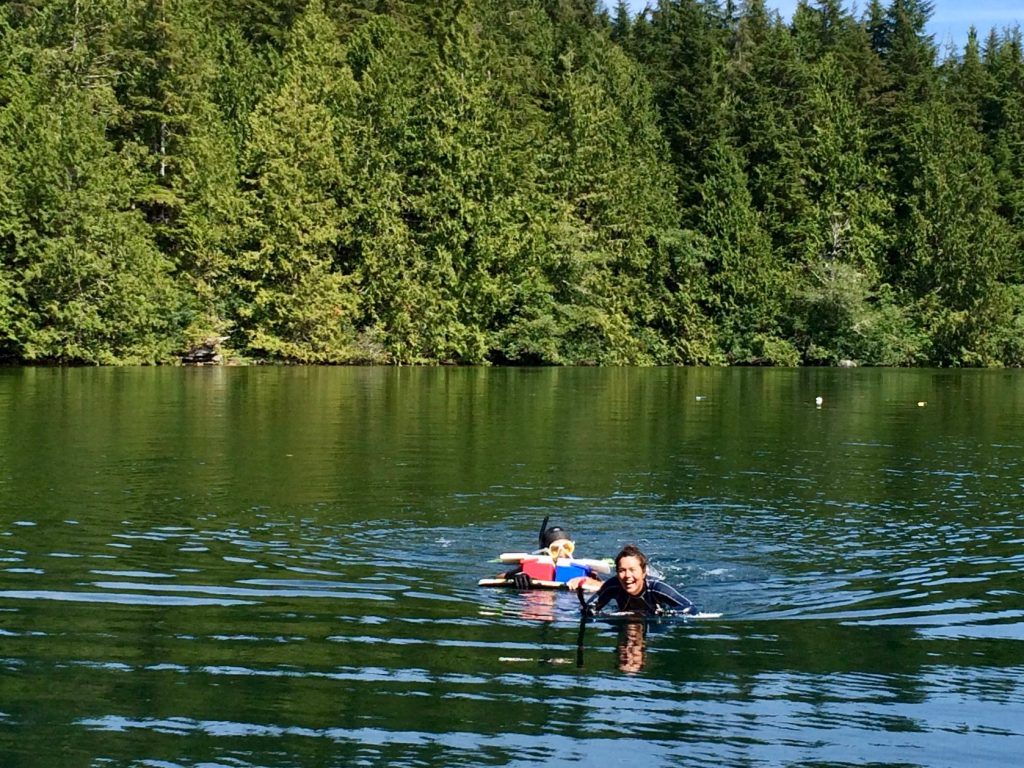
Fiona Francis and Dickson Wong swim back to the boat after data collection. Photo courtesy of Brett Howard
Stomach contents revealed herbivory by green crabs on eelgrass was common, especially in the high-density enclosures where 88 percent of crabs tested had eelgrass in their stomachs. This suggests that when green crabs are in high density environments with increased competition for prey, eelgrass can supplement their diet. Previously, there had been evidence of green crabs foraging on eelgrass on the East Coast, but this was limited to juvenile crabs (Malyshev & Quijón 2011). This ability to adapt their diets to different conditions is one of the ways this species manages to thrive on coastlines around the world. Here on the West Coast, it would appear we have an ongoing struggle between two persistent ecosystem engineers, one autogenic native species (eelgrass) and one allogenic invasive species (green crab). On one hand, like many terrestrial grasses, eelgrass can be quite resilient to disturbance like blade herbivory, so long as it is in a habitat conducive to growth. On the other hand, we know green crabs can be voracious, eating everything including eelgrass, and can live in very high densities on the West Coast. Could high densities of green crab overwhelm eelgrass’ regenerative ability? More than anything, this study demonstrates how important it is that we protect our eelgrass beds from stressors within our control, such as habitat disturbance, excess nutrients, and shading from shoreline structures, so that they are more likely to recover from the effects of grazing green crabs.
–Brett Howard, Ph.D.
Citation: Howard BR, Francis FT, Côté IM, et al. (2019) Habitat alteration by invasive European green crab (Carcinus maenas) causes eelgrass loss in British Columbia, Canada. Biol. Invasions. Vol 21:3607–3618. DOI: https://doi.org/10.1007/s10530-019-02072-z
Species Name: Pagurus hirsutiusculus
Common Name: Hairy hermit crabs
Species Code: PAHI
Geographic Range: Pribilof Islands, Alaska to Monterey, California
Size: Carapace length up to 1.25″ (32mm), but usually smaller
Been feeling a bit hermit-ish this last year? Since leaving our houses could threaten our well-being, we settled into our homes for several seasons. For better and worse, it gave us a chance to closely connect with how good of a fit our living spaces are for us (size, layout, location, etc.), leading to more than a few remodeling projects and some moves. After nearly a year and a half, we may at last be approaching a time when we can leave our homes at will and explore the world with a reasonable expectation of safety. Meanwhile, after about 150,000,000 years, our 10-legged hermit friends seem perfectly content seeking the best fit home for their needs and holing up in their “hermitage” for their own safety.
With more than two dozen species of hermit crab in or near the Salish Sea, we have a pretty rich array to appreciate. That said, only particularly attentive divers get to experience the greatest breadth of Salish Sea species. For those of us exploring the beach at low tide or meticulously sorting the contents of a Crab Team trap, hermit crab encounters typically involve one or both of two common species, the grainy or grainyhand hermit (Pagurus granosimanus, PAGR) and the hairy hermit (Pagurus hirsutiusculus, PAHI).
Being a Hermit
Hermits are in the group of decapod (ten-legged) crabs called Anomurans that only have eight obvious pods. The group also has a pair of antennae on the outside of their eyes, rather than having all their antennae between their eyes just as the “true crabs,” Brachyurans like our iconic Dungies, do. Legs nine and ten are highly modified and small and tucked away to be used mostly for cleaning. But unlike their porcelain or king crab Anomuran cousins, evolution left the hermits with an unarmored abdomen and a need to adjust to life protecting a squishy backside with some kind of shell. Lugging their house around doesn’t always slow them down though. Our hairy and grainy hermits were among the species in a study looking at scavenging behavior that showed hermits were perfectly capable of kicking it into high gear when the smell of mashed mollusks was drifting in the water (Greggor et al. 2016). Not only are they likely to be first on the scene, they are also likely to gather in large numbers and even gain competitive advantages over other small organisms that are after the same food.
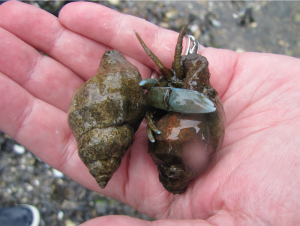
Grainy hermits in a pre-copulatory hold. These are large and similar in size. Sometimes one of either sex may be smaller as research suggests they are more focused on readiness to mate than a size match. Photo courtesy of Jeff Adams
Of course, there’s the issue of reproduction when your reproductive bits are tucked deep in the coils of an inflexible shell. Like other species of crabs, hermits will protect a female with whom they intend to mate. However, instead of the intimate embrace of a red rock or a Dungeness, male hermits just grab the shell of the future mother of their children and drag her around for hours or days until the time is right. Not romantic or even that graceful, but they’ve made it work. They do check in with each other by tapping legs periodically to see if all is ready. When the time comes, mating can’t happen in the shell, so they must leave or mostly leave their shells for a brief time (a few minutes or less usually) to mate, after which, they return to the safety of their shells and the males may continue to protect their mate for a little while.
Grainyhand Hermit Crab: “The Tank”
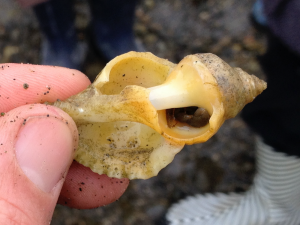
Can you really carry that thing? Tiny grainy hermit in a large frilled dogwinkle shell. Photo courtesy of Jeff Adams
The grainyhand hermit is known for choosing large homes (sometimes ridiculously so) into which it can fully retreat if threatened. Their strategy for survival is to choose the brick house and wait until the wolf gets tired of huffing and puffing. Still, the housing market can be difficult at times. It’s not unusual to find grainy hermits in a shell that you can imagine wasn’t their first choice. A loose barnacle or a piece of a molted crab leg might be the best they can get. If the crab isn’t fully in the shell or if you can convince it to peek out, the bright orange antennae are a quick clue to a grainy hermit’s identity. When you take a look at the legs, you will see they are evenly covered with light to blue bumps that give them their graininess. As they wear their skin for a while, it can erode, showing a lovely shade of blue.
Hairy Hermit Crab: “The Speedster”
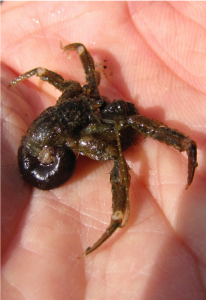
This hairy hermit abandoned its shell, opting for a speedy getaway while exposing its soft abdomen. You can also see the white bands on the legs, and banding on the brown antennae. Photo courtesy of Jeff Adams
Hairy hermits’ shells are typically pretty small (sometimes ridiculously so), not even entirely covering their abdomen and leaving you asking, “Why bother?” When disturbed, they may even ditch the shell so they can flee unencumbered. Sometimes they will take advantage of a larger shell, particularly egg-bearing females who may be wanting a little peace and privacy. Small shell or not, focusing in on legs with light bands and blue bits, and also on stripy (but not orange) antennae, can help you nail down the identification. Still, the hairy hermit is one of those species that can be quite variable in appearance. In fact, their namesake trait is particularly variable, especially as they age. While they share the “hairy” with other crabs in our region (hairy shore crab, hairy helmet crab), the taxonomists went a step further and put “hirsut” right into the species name for these hermits.
Many hairy hermits don’t seem too far outside of the norm of hairs, but once in a while you stumble across one (often larger) that is quite the furball. Hairy hermits are incredibly common, particularly in the intertidal, where they tend to be found a bit higher on the beach than grainyhanded hermits. Some cool research on hairy hermits showed they prefer darker shells and hanging out on darker substrates. They have also been known to make use of shells from nonnative snails like Batillaria attramentaria here in Washington (Wonham et al. 2005*), and even to such an extent that they were able to use the new snails’s shells to expand their range in the San Francisco Bay area (Wicksten 1977*).
So, maybe this has been a bit more of a grainy hermit kind of year, staying tucked safely at home as much as possible. The second half of 2021 may feel more like hairy hermit time, when we still keep our protection close but free ourselves for more exploration. Maybe for 2022 we will molt all our hermit ways and will emerge as red rocks again – top of the crabby food chain and free to roam.
– Jeff Adams
*While we try to link you directly to the research we reference, some of the studies cited in this article are not open access. If you have any questions about any of the works cited here, please feel free to reach out to crabteam@uw.edu.
Have you ever been to Cypress Island Aquatic Reserve? If so, you must have a boat (or a friend with one!), as this reserve is only accessible by water and is located on the largest relatively undeveloped of the San Juan Islands. Managed by the Department of Natural Resource (DNR), this reserve is home to one of the most remote Crab Team sites.
DNR Aquatic Reserve Program
The Cypress Island Aquatic Reserve was established in 2007, adding 6,065 acres of protected aquatic lands in Secret Harbor to the thousands of upland forests, wetlands and grasslands that were already protected under NRCA and NAP designations. The reserve includes state-owned tidelands and marine bedlands, which are managed to conserve and minimize negative impacts to the aquatic habitats.
DNR Aquatic Reserve Program manager Roberta Davenport highlights that while every aquatic reserve in the network has a different management plan, “monitoring and managing invasive species is a high priority” for all of them. Davenport points to the mobile nature of European green crab to highlight why collaboration across geography and partner agencies and organizations is critical to managing this invasive species. In 2017, Crab Team teamed up with DNR to launch a new Crab Team monitoring site in the Cypress Island Aquatic Reserve at the south end of the island in Secret Harbor.
Puget SoundCorps
Since 2017, Crab Team monitors at the Cypress Island Crab Team site have been a mix of DNR staff and Puget SoundCorps (PSC) members. The Puget SoundCorps is a statewide program administered by the Department of Ecology’s Washington Conservation Corps that provides hands-on opportunities for people who are new or returning to the workforce. Multiple partners and agencies participate by providing job opportunities and skills to prepare participants for future employment. The Aquatic Reserves Puget SoundCorps, in particular, appeals to folks who are interested in natural and marine science. Members of this specialized team engage in a host of scientific field work opportunities, collecting critical monitoring data that DNR uses to inform reserve management decisions.
When they’re not out monitoring with Crab Team, the Aquatic Reserves PSC members are busy with their many other monitoring efforts including forage fish spawning surveys (contributing the Washington Department of Fish and Wildlife statewide forage fish spawn database), seagrass surveys (contributing to SeagrassNet, a global database) and marine debris pick-up efforts. PSC Team Lead Erin Stehr manages these monitoring efforts and works hard to provide her team with career development opportunities. For example, all team members are asked to step into a project leadership role during their 11-month positions where they are responsible for data entry, management and communication with monitoring partners. This year, Hanna Bridgham is leading the Crab Team monitoring efforts for the Aquatic Reserves crew. This project offers an incredible opportunity for leads like Hanna because she has the opportunity to join management meetings and interact with management partners to round out her understanding of the larger European green crab management efforts in the state.
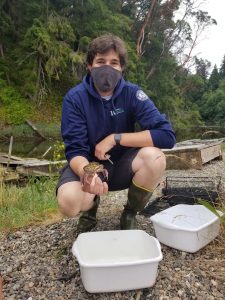
PSC member Ben Papadoplous handles crab caught in Crab Team trap survey. Photo courtesy of Lilya Jaeren
Ben Papadopoulos was a member of the Aquatic Reserves Puget SoundCorps team in 2020 and returned as the assistant supervisor this year. When asked to reflect on his PSC experience, Papadoplous said that he values the opportunity to wear many hats in the program, which he hopes will help prepare him for a future career in public health, bioinformatics and/or food security. PSC members like Papadopolous also expand our early detection capacity in the region by putting more trained boots in the mud. Along with DNR staff, PSC members conduct Crab Team monitoring at two sites in the 55-site Crab Team network, on Cypress Island (Cypress Island Aquatic Reserve) and Anderson Island (Nisqually Reach Aquatic Reserve). In 2020, PSC crew members stepped in to help WDFW and Northwest Straits Commission staff with trapping efforts in Drayton Harbor when they needed more hands on deck. Also, in 2018, an eagle-eyed crew of PSC members spotted a European green crab molt in Fidalgo Bay while conducting other monitoring efforts, unrelated to Crab Team. Their call initiated an assessment trapping by WDFW, which thankfully turned up no live green crab in the area. PSC members take their training with them even after their term ends. Many have gone on to work in natural science positions around the state keeping a wary eye out for green crab while doing so. Leveraging the skills of managers who work across large geographies in this way is a huge benefit of the Crab Team early detection network, and builds management capacity in the state in a cost effective way.
Cypress Island restoration
The location of the Cypress Island site in Secret Harbor, in particular, has changed substantially over the years. Members of the Samish Indian Nation have many pre-contact, historic and modern uses on the island, including fishing, practicing spirituality and ceremonies, harvesting plants and living seasonally and year-round. In 1855, new homesteaders began transforming the south end of the island by diking the tidal flow, filling a salt marsh and draining wetlands. The fishing industry established a foothold in Secret Harbor in the 1900s, operating a salmon hatchery from 1900-1920 and later established fish farms in the harbor. In 1949, Secret Harbor became home to the Secret Harbor School, a residential school for boys that operated on the island until 2008. When DNR acquired these lands in 2009, a massive, years-long restoration project began. More than 30 structures were taken down, restrictive dikes and berms were removed and additional channels were added to enhance connectivity between freshwater and saltwater environments. Over time, these channels have shifted and branched and salt marsh vegetation has slowly started to return.
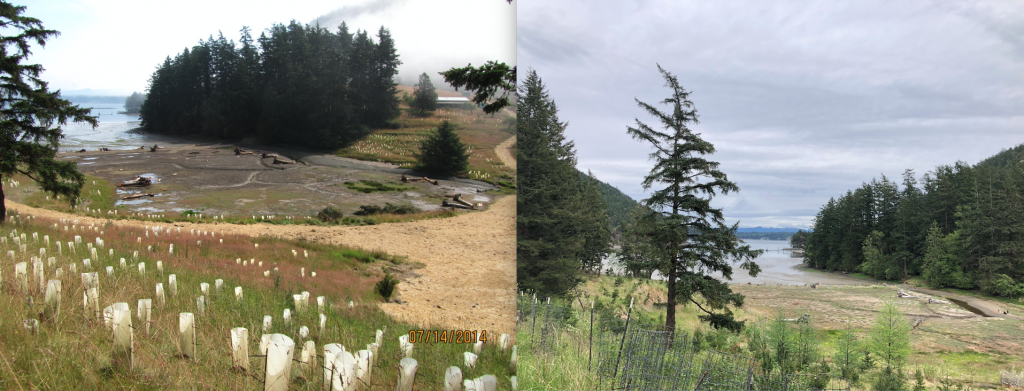
View of Secret Harbor in 2014 (left) and in 2021 (right). Photos courtesy of Erin Stehr (L) and Emily Grason (R)
As natural forces continue to work on these restored lands, DNR staff have watched the vegetation return in real time. In fact, the location of the Crab Team shoreline survey has shifted a full nine meters toward the water since the site was established in 2017. Data from Crab Team surveys provide important insights into how the flora, fauna and topography of this shoreline are changing as the estuary rebounds. Several additional Crab Team sites located in restoration areas like this offer unique opportunities to observe changes like this, including Discovery Bay (Port Townsend), Carpenter Creek (Kingston), and Post Point (Bellingham). Three more Crab Team sites (Duckabush, Titlow, and Harper) are also slated for restoration projects in the future.
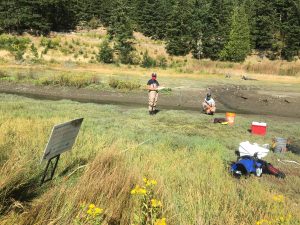
PSC members Abby Jackson and Malise Yun busy documenting different shoreline features during Crab Team monitoring. Photo courtesy of Erin Stehr
These observations provide a broader picture of ecosystem dynamics at these locations, contributing to a long-term dataset that can be used by groups beyond Crab Team. For example, because most restoration monitoring efforts focus only on habitat use by salmonids, Crab Team monitoring dramatically expands the scope of information gathered, both in the duration of monitoring efforts and the diversity of organisms observed. This wide breadth of data provides managers with a more inclusive view of how restoration processes unfold in these re-engineered systems. Ultimately, Crab Team data play an important role in deepening our understanding of pocket estuaries and salt marshes in our region. We are grateful for our Crab Team partners and volunteers for working together to build this resource across the Salish Sea!
–Amy B. Linhart
Photo Gallery
We love to get the virtual experience of monitoring with all of the Crab Team volunteers. Do you have a photo to share? Send it to crabteam@uw.edu. (Click on arrows to scroll, and photos to enlarge for more detail.)
